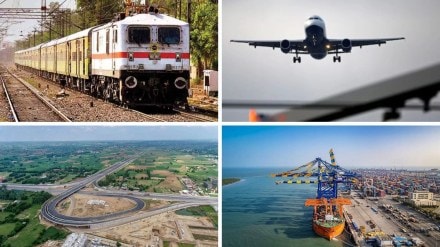The Pradhan Mantri Gati Shakti National Master Plan is a monumental Rs. 100 lakh crore investment initiative set to reshape India’s infrastructure over the next five years. Launched by Prime Minister Narendra Modi on October 13, 2021, the plan was unveiled on the 75th Independence Day as a significant step toward transforming the nation’s infrastructure landscape. The PM Gati Shakti National Master Plan aims to accelerate project completion and improve India’s global competitiveness by reducing project timelines and overcoming inter-ministerial obstacles.
PM Gati Shakti will integrate infrastructure projects from various Ministries and State Governments, including Bharatmala, Sagarmala, inland waterways, dry ports, and UDAN. It will also cover economic zones such as textile clusters, pharmaceutical hubs, defense corridors, electronic parks, industrial corridors, fishing clusters, and agricultural zones to enhance connectivity and boost the competitiveness of Indian businesses. The plan will leverage advanced technologies, including spatial planning tools and ISRO imagery developed by BiSAG-N (Bhaskaracharya National Institute for Space Applications and Geoinformatics).
What are the six key pillars of PM GatiShakti National Master Plan?
- Comprehensiveness – Integrating all existing and planned initiatives through a centralised portal to provide visibility and critical data across departments.
- Prioritisation – Allowing departments to prioritise projects through cross-sectoral interactions.
- Optimisation – Helping ministries identify critical gaps and select the most efficient routes for goods transportation.
- Synchronisation – Enhancing coordination among ministries and reducing project delays by breaking down silos.
- Analytical – Offering a GIS-based platform with over 200 layers for comprehensive spatial planning and data visibility.
- Dynamic – Enabling real-time monitoring and progress updates of cross-sectoral projects via satellite imagery and regular portal updates.
What was the need to implement PM GatiShakti National Master Plan?
Traditionally, a lack of coordination among departments led to inefficiencies, such as the repeated digging up of newly constructed roads for tasks like laying underground cables and gas pipelines, causing both inconvenience and wasted resources. To mitigate these issues, efforts have been made to synchronise activities so that all necessary installations, like cables and pipelines, are completed simultaneously.
Additionally, steps have been taken to streamline the approval process and reduce the complexity of regulatory clearances. Recently, the government has adopted a comprehensive approach to infrastructure development, focusing on integrated planning and execution. This approach aims to eliminate siloed project planning, ensuring that major infrastructure projects are designed and implemented with a unified vision.
What are the key advantages of PM GatiShakti National Master Plan?
- Centralised Portal: The plan establishes a centralised portal to integrate the infrastructure efforts of 16 central ministries and departments.
- Improved Coordination: It facilitates better cooperation among ministries, providing a unified transportation and logistics grid to streamline data flow and expedite project clearances.
- Large-Scale Projects: The scheme will support major infrastructure projects such as UDAAN, railway network expansion, Bharatmala, Sagarmala, inland waterways, and Bharat Net.
- Employment Generation: The plan is expected to generate significant employment opportunities across various sectors.
- Multimodal Connectivity: It aims to enhance multimodal connectivity, prioritise resource optimisation, and address challenges related to standardisation, disjointed planning, and clearances.
- World-Class Infrastructure: The mission seeks to develop world-class infrastructure and improve logistical synergy across different transportation modes.
- Economic Growth: The overarching goal is to boost India’s competitiveness and drive economic development.
What is the aim of PM GatiShakti National Master Plan?
- National Highway Network Expansion: The plan aims to extend the national highway network to 200,000 kilometers.
- Aviation Infrastructure Development: Approximately 200 new airports, heliports, and water aerodromes will be constructed to enhnace aviation capabilities.
- Railway Cargo Capacity: The railway network’s cargo handling capacity will be increased to 1,600 tons by FY25.
- Power Transmission Network: The power transmission network will be expanded to 454,200 circuit kilometers to improve accessibility.
- Renewable Energy and Gas Pipelines: The initiative targets increasing renewable energy capacity to 225 GW by FY25 and completing around 17,000 kilometers of gas pipelines.
